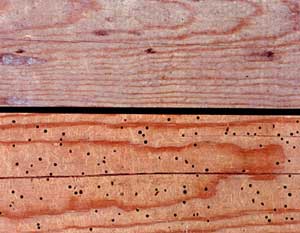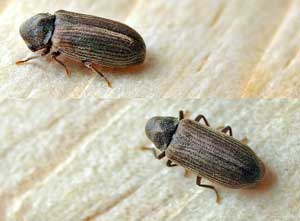A complete guide to treating woodworm. Woodworm, the name that can be given to several different types of wood-boring insects, is currently not as much of a problem in the UK as it is in other countries. However, this does not mean that it can be totally ignored. Traditionally built brick houses have little in the structure which can be attacked by woodworm, the notable exception being the roof trusses. However, as house building practices change to include more wooden framed houses, the need to prevent against woodworm is likely to become a problem for more and more homeowners.
Of course it is not only the structure of a house which can be damaged by wood-boring insects, solid wood furniture and flooring is also at risk. Woodworm particularly like the linings of drawers and the backs of wardrobes (more so solid wood than MDF or chipboard) because they have a taste for some of the glues used and these areas are usually untreated. Finding, identifying and treating woodworm quickly is essential to stopping further damage and further spreading of the larvae.
Treating Woodworm

If you think you have woodworm in the structural timber of your house, you should always seek the advice of a professional. The extent of the damage could be much worse than it first looks and a qualified pest control company can advise on the best course of action. You may be advised that the wood worm outbreak is minor, in which case you can treat the areas yourself with a chemical insecticide spray. This is available from most DIY stores and online. If you are in any doubt about the severity of your woodworm problem in the structural elements of your house, ALWAYS seek professional advice.
Treating Woodworm in furniture can be best achieved by injecting woodworm fluid into the flight holes that the adults make when they emerge. You don’t need to inject every hole, but make sure you inject every 50-100mm. Paint the untreated wood with a couple of coats of the fluid to further protect it. Hard to reach areas can be sprayed with aerosol based woodworm fluid. Make sure you check and treat any old pieces of furniture that you bring in to your home, as this can introduce woodworm into your home.
Preventing Woodworm
Keep rooms well ventilated and avoid allowing humidity to rise above about 12% for any extended period of time. Treat any new timber with a chemical preserver before it is painted or stained (once it is dry, you can treat the wood as you would any other). You can also buy insecticidal polish for use on furniture which will also help to reduce the chances of further infestation.
Types of Woodworm
Woodworm, as mentioned above, is actually a generic name given to the larvae of several types of beetle. In the UK the most widespread is the Common Furniture Beetle, but there are several other types of wood-boring insect you may come across.
Common Furniture Beetle

Adult furniture beetles are small (between 2.5mm and 5mm long), brown and can be difficult to spot. They lay their eggs in the cracks of seasoned timber, preferring humid and unventilated areas. The larvae then burrows into the wood for up to 4 years eating the starch in the wood grain, before creating a small area near the surface of the wood and pupating. Adult beetles then hatch out and break out through a small hole. This hole, and the dust (or frass), may be the first visible sign of an infestation. The adult beetle then looks for another crack to lay eggs and the process continues. It is thought that 75% of UK houses contain at least some Common Furniture Beetles.
Deathwatch Beetle
Not as common in the UK as other types of wood-boring insects, but still a problem in some areas. The deathwatch beetle larvae grow up to about 7mm long and create much larger holes of up to 6mm in diameter, so an infestation can very quickly cause major damage. Deathwatch beetles prefer hardwoods such as oak or elm, and so can be a particular problem in older houses where these materials are more commonly seen as part of the house structure. Deathwatch beetle larvae can bore through the wood for up to 7 years before emerging as adults. Authorities are keen to keep the levels of deathwatch low, so if you think you have an infestation, it is a good idea to contact your local Environmental Health Department.
House Longhorn Beetle
Also sometimes called the Old-House Borer Beetle, the House Longhorn actually does not prefer old houses over new builds. The House Longhorn damages wood in the same way as the common furniture beetle, by laying eggs in cracks and splits, with the larvae then boring through the wood for up to 3 years. Longhorn beetles prefer to lay their eggs on softwoods and in particular pine. As with Deathwatch Beetles, the emerging adults create large holes and can therefore quickly cause major damage.
Other types of wood-boring insect found in the UK include Weevils and Powderpost Beetles. However, these are much more uncommon than any of the beetles mentioned above.
Where to Look for Woodworm
Woodworm are more likely to be a problem in rooms which are humid or badly ventilated. Look at the untreated areas of any wooden furniture, such as the linings of drawers and the backs of wardrobes. The wooden frames of upholstered furniture is also a prime place to find them. Whilst woodworm in your furniture could be a costly problem, woodworm in the structural wood of your home could be a disaster. Check the timber joists in you attic space whenever you have chance and also take a close look at the bottom of doors and doorways. Skirting boards and the top edge of picture rails are also favourite places for wood-boring insects to lay their eggs.
[amazon_link asins=’B071NW5KZF,B007RA1TSI,B005QKIVZK’ template=’ProductGrid’ store=’subscribeands-21′ marketplace=’UK’ link_id=’ab5a5566-14e2-473d-955c-aaed44540c92′]







